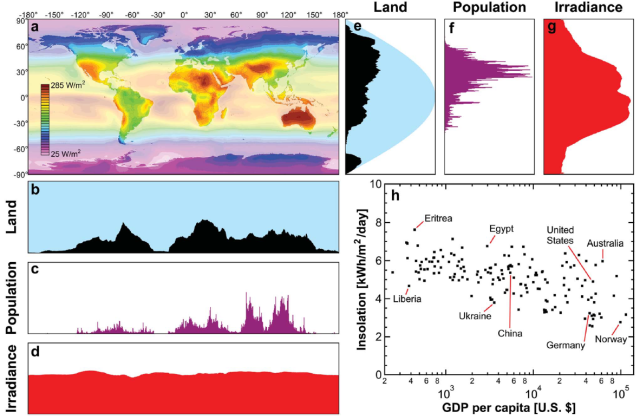Analysis: Solar is the Equitable Energy Source
There are potential benefits for everyone when governments support the advancement of solar technology and economic development plans for equitable energy.
Solar energy is touted for a variety of reasons: it is renewable, clean, and quiet, and can be used as a decentralized form of electricity generation. But while doing some reading I came across a figure that reveals a less-discussed benefit of using solar energy that may be most important—depending on your priorities when it comes to global issues.
Below is the figure, reproduced from a recent 2015 paper in Energy and Environmental Science that reviewed all that we know about the solar resource and the technology we’ve created to harness it. I’ll show it first and then discuss its important details.


There’s a lot going on here, so let’s break it down. The top left image ( figure a) shows the irradiance, or power per square meter (W/m2), as a function of geography. This tells us just how much solar energy is hitting the surface over a given time and area. As would be expected, the most solar power arrives closer to the Equator, with the largest amounts of available power located in the US Southwest, Sahara, central Asia, and Australia.
Solar Energy for All
However, the intriguing benefits of solar as an equitable energy source are revealed when we look at averaging this available power across longitudes or latitudes. Figures b, c, and d plot land area, population, and irradiance as a function of longitude, averaged across latitude. Notice how solar power is consistently available across all longitudes (figure d)! To a certain limit, it doesn’t matter where you live in the Eastern or Western hemisphere—solar power will be available to you.
Figures e, f, and g similarly plot land, population, and available solar power as a function of latitude, averaged across longitudes. Here, we see a slightly different but still beneficial pattern. Clearly, less solar power is available near the Arctic and Antarctic poles (figure g), but the level of irradiance still generally correlates with the largest population densities, particularly near the 30 degrees N latitude line (compare f and g).
So, on average, people around the world live close to available solar power. That’s a good start, but there’s more! Figure h plots the GDP per capita of countries in 2011 against the amount of solar energy hitting that country per square meter per day (known as insolation). This type of scatter plot is a great tool for visualizing correlations between two variables. If GDP per capita and insolation were positively correlated, for example, then we would see richer countries having much higher levels of insolation than poorer countries. Fortunately, that’s not the case! Instead, almost no correlation exists between these two variables—indicating that all countries have a similar potential to harness solar energy to power their homes, businesses, and communities.


Leveling the Playing Field
Consider the implications of equitable energy. Across geography and wealth, no country lacks direct access to sunlight as an energy source. The same cannot be said of coal, oil, or natural gas, all of which require extraction of resources from geographically specific locations. Developing countries with less GDP per capita even have a slightly larger solar resource, on average, indicating the potential to use capital investment and infrastructure in the solar industry to spur growth in these countries.
Of course, developing countries can do little with the available solar energy if their governments or policies are not equipped to take advantage. But no extractive energy resource boasts these benefits of geographic and economic equality. Just another reason to support the advancement of solar technology and economic development plans that encourage its distribution!
Related: Sunlight Powers Recycling of Carbon Dioxide and Plastic
Science Policy Challenges
Join Dr. Jonathan Trinastic for an investigation of four major science policy challenges facing the public and discusses how the federal government can work with scientists to find equitable, just, and sustainable solutions. We hope you will enjoy these and stay tuned for more articles exploring all the ways in which science informs the difficult choices our governments at all levels must make to allow all citizens to lead productive and healthy lives.
READ MORE: SCIENCE POLICY CHALLENGES IN FOUR PARTS
More About Solar Energy
IMPROVED SOLAR POWER WITH NEW ORGANIC SENSITIZERS
CHILEAN SOLAR FARM: CHEAPEST POWER PROJECT EVER
SOLAR-POWERED OXYGEN SAVES LIVES IN AFRICA
NEW SOLAR CELLS INSPIRED BY 400-YEAR-OLD ART
SOLAR ENERGY THAT DOESN’T BLOCK THE VIEW
NEW SOLAR ENERGY STORAGE WORKS AT NIGHT
SOLAR POWER MATERIAL 90 PERCENT EFFICIENT
Reference
Jean, J. et al. (2015). Pathways for photovoltaics. Energy and Environmental Science, 8, 1200-1219.
About the Author
—Dr. Jonathan Trinastic earned his PhD in physics at the University of Florida and is a policy fellow in the Solar Energy Office within the Department of Energy in Washington, DC. He is interested in renewable technology and sustainable energy policies, as well as living by Schumacher’s mantra that “small is beautiful.” Follow Jonathan on Twitter @jptrinastic.
A version of this article was previously published on the Goodnight Earth blog and in Science Connected Magazine.



